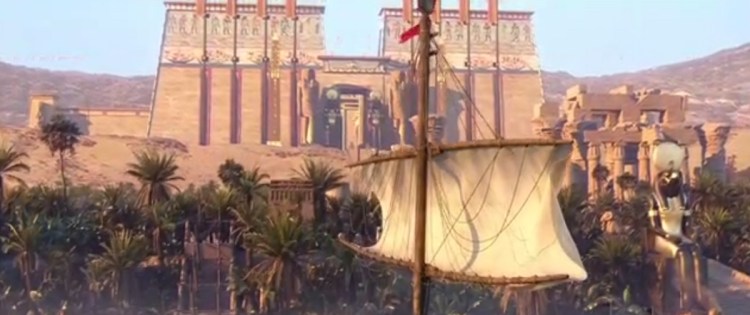Ubisoft created such a massive world for Assassin’s Creed: Origins, the latest open-world game set in the world of ancient Egypt. And one of the people responsible for that massiveness was Raphael Lacoste, art director on the project.
He spoke at the 2017 Montreal International Game Summit (MIGS 17) about how Ubisoft undertook the massive task of making the art for Assassin’s Creed: Origins, which took an extra year to make compared to earlier Assassin’s Creed games. Lacoste was also the art director on Assassin’s Creed IV: Black Flag, which debuted in 2013. I interviewed Lacoste after his talk about the modern craft of making art for triple-A games.
Ubisoft had hundreds of artists. They took inspiration from teams that went to modern Egypt and documented the real-world look of things. But the artists also had to do research on artifacts that are no longer around today, and they had to imagine things that weren’t documented — like how a room might have looked in ancient Egypt. All of it came together in an immersive open world that has a life of its own — so much so that Ubisoft is releasing Discovery Tour by Assassin’s Creed in the new year as an educational title for children.
Here’s an edited transcript of our interview.
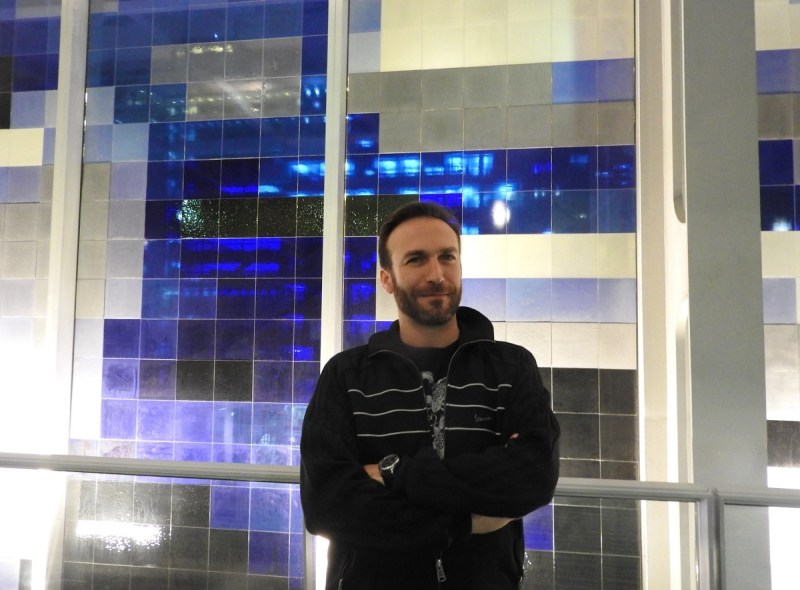
Above: Raphael Lacoste was art director on Assassin’s Creed Origins.
GamesBeat: How would you summarize your talk?
Raphael Lacoste: It’s always surprising how we find inspiration to create interesting worlds, places you want to explore and spend time. I talked about the importance of taking all these trips to find interesting inspirations. With Black Flag, we went to Havana and other places to gather a lot of reference.
It’s also important to know that even if we’re making historical games, we’re not making documentaries. It’s about creating an interesting, entertaining piece inspired by something real and historical. Finding the right balance between [what’s] credible and realistic and what’s a little stretched in terms of immersion. We try to bring emotion to the player through the environment design, as well as character design and story.
GamesBeat: With Origins, it sounded like the world was far bigger than Black Flag or anything else.
Lacoste: It’s pretty different, yeah. At the beginning, when we wanted to create the open world, we had the idea of creating this massive desert and having some oases. But we found out that’s not anything like the real Egypt. We wanted to create all this diversity, all these contrasts. We have the open desert, the lush Nile delta with the swamps and the crocodiles. We also have the mountains in the eastern desert and the massive mountains of the Libyan plateau. There’s a lot of diversity.
In Black Flag, we had the open world of the ocean plus the islands and some linear sequences in the jungles and other locations. With Origins, we had this massive sandbox that was completely open. It wasn’t limited in any way. It’s seamless, too, with no loading. In Black Flag, we had to compromise with some loading, but in Origins, it’s fully seamless.
GamesBeat: Did you guys spend a lot of time on sand?
Lacoste: We underestimated the water in Egypt as well. It’s very important because it’s all built around the Nile. All the cities and locations were built along the Nile. We had to have very interesting water, all different types of water. You had muddy water and swampy water but also the ocean, the Mediterranean in the north, and the river to the south. We also had oases, some of them with salty waters. Faiyum Oasis is pretty big. We had quarries with pools and natron mines. A lot of different kinds of water.
GamesBeat: Is there a point where you have to say, “It’s too much,” [and] stop collecting new pieces of art?
Lacoste: The ambition is always pretty huge in the beginning, and then, we have to check ourselves to keep up the quality control and deliver something interesting. The scope is pretty huge to start, and then, we try to control that scope.
GamesBeat: Another talk went into the AI system, where you can follow alongside someone in the world, and you’ll see them just go about their entire day. Does that have implications for the art in the world as well?
Lacoste: It’s the first time we used this kind of NPC AI system. We don’t have any staged events. You might be on a mission, and you arrive in a place where they have a tannery for instance. You’ll see people working there. But if you go there in the night, those people will be asleep. It gives more credibility to the world. In that same village, you’ll see the same people sleeping on the rooftops. The kids will be on the carpets. Maybe they’ll have some candles. During the daylight, nobody will be on the roof, but they’ll be working in the shade.
We have an intelligent routine for all the NPCs. They’ll travel in the world as well sometimes. We have nomads and caravans, people carrying resources in the open world. It’s an interesting implication for gameplay because you can randomly loot some items that way.
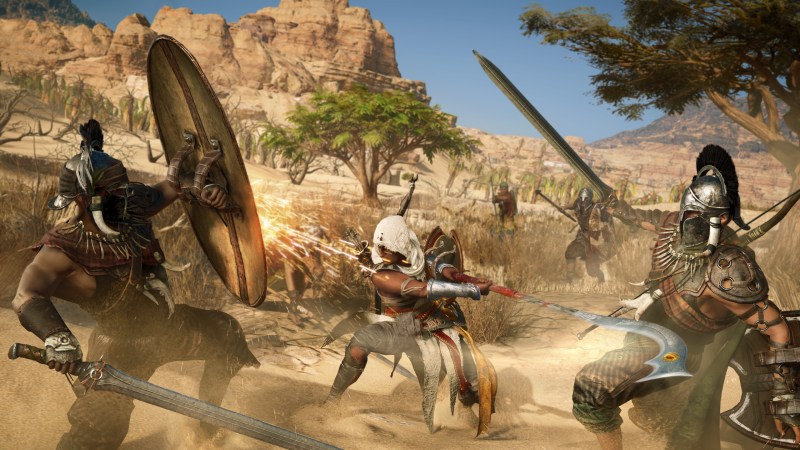
Above: Fighting feels different in Assassin’s Creed: Origins.
GamesBeat: As far as research goes, what did you find that was interesting, that might have been conflicting in some ways that you had to make decisions around? One thing I think of, there’s always some kind of debate about exactly what Cleopatra would have looked like.
Lacoste: We tried to respect history as much as we could with the characters. We had an idea at the beginning around Julius Caesar. We thought he would be blond, and we gave him blue eyes, but it ended up that he looked too much like a typical bad guy. We did some more homework and did a lot of research into his background, and it turned out that he had black eyes. That led to our version of Caesar with the black eyes and brown hair or more gray hair.
Cleopatra was Greek, not Egyptian, so we wanted her to have a lighter skin tone, not so much of the clichéd Egyptian princess. A different direction than if we had been creating Nefertiti for instance. She was Egyptian while Cleopatra was more Greco-Roman-Egyptian.
Above all, we wanted to bring interesting moments to our players. For the environment design, for the cities, for the landmarks, we did a lot of research. We worked with Jean-Claude Golvin, who’s a historian and an illustrator. We worked with him on the placement of the landmarks. But to bring more emotion, we stretched the size on some things. Some of them are way bigger in the game because we wanted to create this sense of pharaonic scale in places like Alexandria and Memphis.
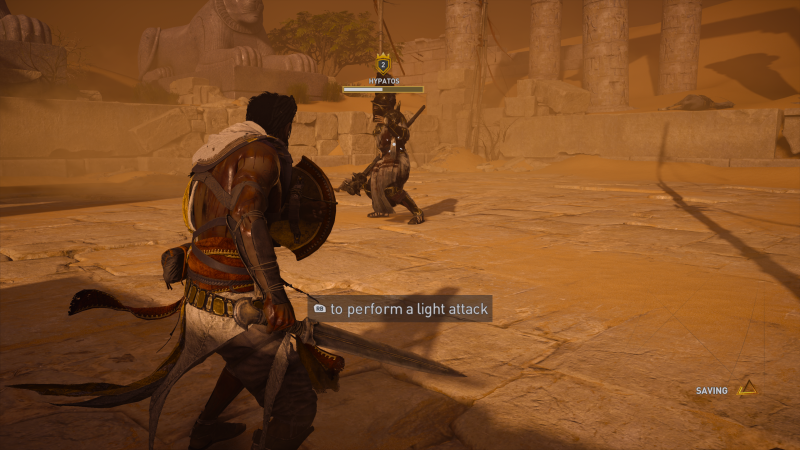
Above: Assassin’s Creed: Origins has a weird control scheme.
GamesBeat: What sorts of other things added to the sense of immersion like that?
Lacoste: You have the personal motivation behind what [the player’s character is] going through. Beyond that, the sense of immersion in Egypt comes from many things. You have the effects — like adding a sandstorm when you’re in the desert. Adding this feeling of threatening atmosphere but also feeling the heat, the scorching effect of the sunlight when you’re lost in the desert. You have hallucinations when the heat takes over. When you arrive in an oasis, you have this feeling of a beautiful green place, which contrasts a lot with the dry desert.
Immersion comes in a lot of ways from those contrasts. The same thing happens when you’re in this magnificent Greco-Roman city, and then, you go from there to a place like Memphis, which is much more of the old Egyptian empire. It’s 3,000 years old even in the time of the game. It’s all about feeling those contrasts as you go through different kinds of immersion.
GamesBeat: You guys did the discovery tour as well. Did that impact what you were doing, or were you already creating everything before that?
Lacoste: The discovery mode is very interesting because we built this amazing huge world with a lot of rich environments, but when you play the game, you’re fighting bosses, fighting all these enemies. It’s pretty violent. But we wanted to bring the quality of the world to different people — like children or my grandmother. People who would be really interested in traveling in the open world. So, we had this mode where we deactivated everything violent, every challenge. It’s a way to use what we created and bring that to a different kind of application.
GamesBeat: Did that create a different feeling for the art team, creating something educational?
Lacoste: I worked with the mission designers creating all the tools for the app. We decided to choose certain locations at certain times of day, so we could get the best possible lighting to reveal things like the lighthouse at Alexandria or the pyramids. With the pyramids behind Memphis, it’s all about showing off the work done by the artists and the level designers, bringing that to casual gamers or people who don’t even play games. People who want to just enjoy the beauty of the world and the history.
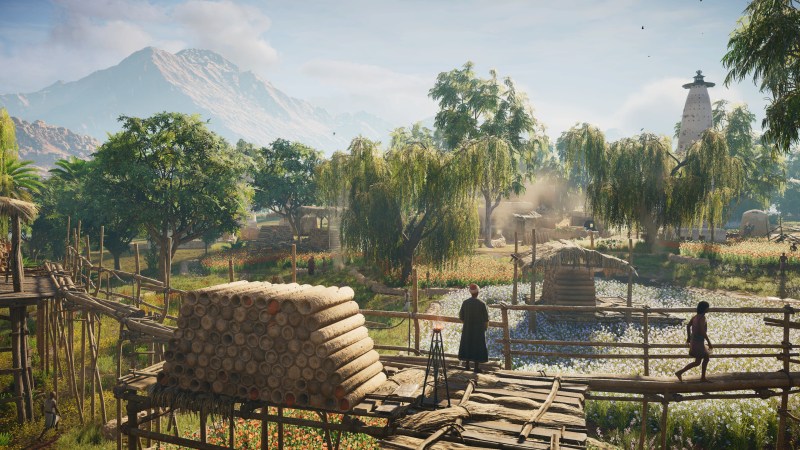
Above: It’s not all sand.
GamesBeat: Now that the game has been out, what have you heard as far as feedback about the art?
Lacoste: It’s been pretty good. We always have some glitches, and we’re fixing them all the time in title updates. Even when I play at home, I’m seeing stuff to improve. We’ve had time to polish the game, though, and we’re getting some pretty amazing feedback.
People are using the photo mode now and posting pictures. They tag me on Twitter a lot, so I can see their photos. I see a ton of them every day, people taking the time to make portraits of different things in the open world, the diversity of the open world, new outfits in different settings. The photo mode has been pretty huge. I think we’ve had a couple of million pictures taken so far? The server load is insane.
I’ve even had some feedback from people who’ve just played the game to be in the open world and walk around and take photos. Even from gamers. They just want to spend time exploring, which is pretty cool.
GamesBeat: Do people look around for any interesting anomalies or anachronisms in the world, stuff that isn’t exactly historical?
Lacoste: Oh, yeah.
GamesBeat: One thing I wondered about was whether eagles were native to Egypt.
Lacoste: The eagle we have in the game is actually a Bonelli’s eagle. It’s native to this region. It’s from there. But for sure, sometimes we stretch a bit. As I say, we’re not making a documentary. We’re making a game. Sometimes, we stretch a bit to have a more interesting, impactful experience. But it’s pretty [well documented], pretty credible in terms of the environment, the animals. If you go out into the desert, you’ll run into snakes, hyenas, lions. In the swamp, you’ll meet crocodiles and, of course, the eagles.
GamesBeat: When you do that kind of world building, you can visit the place and do research, but what happens with things that aren’t there anymore?
Lacoste: It’s a challenge for all the creative people on the team. If you tell us to recreate a building in Montreal exactly in a game, that’s really not very interesting. But if you tell us, “OK, imagine how this place might have been 2,000 years ago,” it triggers our [imaginations] and creativity. That’s something we like to do. Origins was a very different challenge.
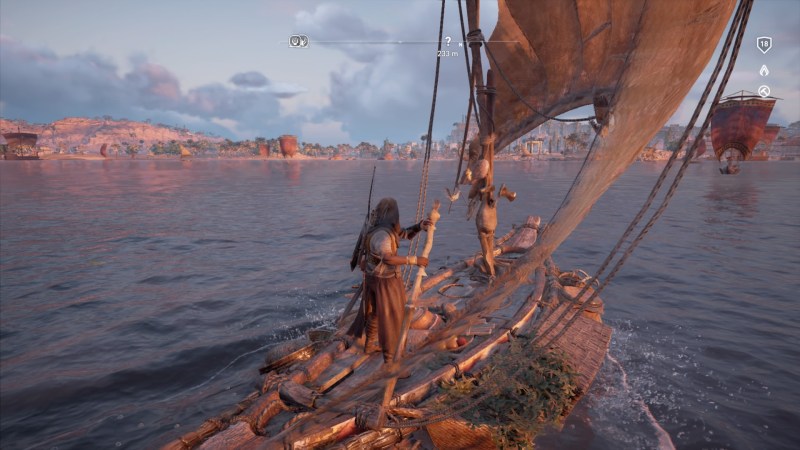
Above: It’s a beautiful day to go sailing.
GamesBeat: In something like a Pixar movie, they never have to build a complete world. If something isn’t going to be in the shot, they don’t have to build it. Do you have the same luxury in some ways, or do you really have to build everything?
Lacoste: Yeah, we have to build everything. That’s the big challenge. An open-world game is really about creating that 360 view. The challenge we have is not like in a linear game, where you can craft that linear ride. In an open-world game, we have to think about, say, what could be a generic asset that we could use to fill that 360 view of the world? It’s a different way of building things like landscapes.
GamesBeat: Do you have any other solution besides just throwing lots and lots of artists at the problem?
Lacoste: We’ve created new procedural techniques for Origins. We used new tools to fill the landscape with things like rocks and grass and trees. But every time we discover a location, the locations are handcrafted. If you come on a village or a city or a point of interest, that will be crafted by a level designer, a level artist. But if you’re in the open desert, open jungle, the swamp, a huge place, we used procedural tools to set up some visual rules, a basic recipe around a certain kind of [tree], a certain kind of [bush]. That can fill a huge amount of space.
GamesBeat: So, that makes the art tasks a bit more manageable?
Lacoste: A bit. But we’re still almost 1,000 people working on Assassin’s Creed. Maybe 800 or 900 worldwide, and 300 in Montreal alone. On the pure art side, it’s still pretty huge, 200 or 300 people. It’s pretty big. That includes animation, visual effects, cinematics, level artists, level designers, lighting.
GamesBeat: You must go crazy trying to keep track of it all.
Lacoste: We have a lot of directors, too [laughs]. I have assistant art directors in all the different studios. We do regular reviews. I’m lucky because they’re all very good guys. They can manage their teams. We have a team in Singapore, a team in Montpellier, France, a team in Shanghai, a team in Sofia, Bulgaria. A lot of different teams, over four years.
Disclosure: The organizers of MIGS 17 paid my way to Montreal. Our coverage remains objective.
